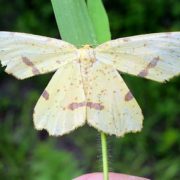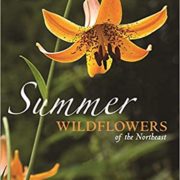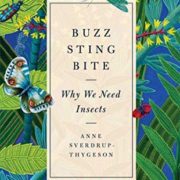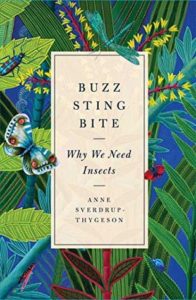This article by Anne Raver originally appeared in our WildfloraRI, Spring 2021
You can’t help but wonder how the beavers are doing on Rhode Island, if you read Jeff Goldfarb’s Eager: The Surprising Secret Life of Beavers and Why They Matter. Our RIWPS book club had discussed Eager in early March 2021, marveling at the abilities of this natural engineer, Castor canadensis, to hold and cleanse water, and to create habitat for myriad species of plant and animal life. (Beavers also flood roads, farm fields and septic systems; and they kill trees. But more on that later.)
 Goldfarb fires the imagination with images of pre-historic North America, where beavers crossed the land bridge millions of years before humankind and may have numbered between 60 and 400 million before the year 1600. Forget that idea of clear, racing streams and wide rivers flowing through the wilderness. Beavers, driven to build dams, turn running water into mucky ponds and marshlands. As Goldfarb puts it, “a sluggish, murky swamp, backed up several acres by a messy concatenation of woody dams. Gnawed stumps ring the marsh like punji sticks; dead and dying trees stand aslant in the chest-deep pond. When you step into the water, you feel not rocks underfoot but sludge. The musty stink of decomposition wafts into your nostrils.”
Goldfarb fires the imagination with images of pre-historic North America, where beavers crossed the land bridge millions of years before humankind and may have numbered between 60 and 400 million before the year 1600. Forget that idea of clear, racing streams and wide rivers flowing through the wilderness. Beavers, driven to build dams, turn running water into mucky ponds and marshlands. As Goldfarb puts it, “a sluggish, murky swamp, backed up several acres by a messy concatenation of woody dams. Gnawed stumps ring the marsh like punji sticks; dead and dying trees stand aslant in the chest-deep pond. When you step into the water, you feel not rocks underfoot but sludge. The musty stink of decomposition wafts into your nostrils.”
Beavers, North America’s largest rodent, seem to be drawn to the sound of running water and driven to build dams of sticks and logs, packed with stones, grass and mud. These nocturnal mammalsusually construct a mounded lodge of logs and sticks in the pond behind the dam or on the edge of the bank. Plastered with mud, these cozy lodges remain above freezing, and are big enough for a male and female, who mate for life, to raise their young. The juveniles remain for two years, then move out to find mates and new territory. The pond has to be deep enough to enter and exit the lodge underwater, and to reach a submerged cache of tender stems of woody plants and roots for winter food. This watery lifestyle offers protection from land-dwelling predators.
Beavers’ back feet are webbed, and their front hand-like, clawed feet are built for digging and grasping sticks. Their incisors, which never stop growing, are sharpened and filed by constant gnawing. A beaver’s large, flat tail doubles as a rudder when swimming and as a prop when standing to chew down a tree. The animal’s transparent eyelids allow it to see underwater.
Indigenous people revered the beaver for many reasons. “Beaver is a hardworking animal,” said Lorén Spears, the executive director of the Tomaquag Museum in Exeter. “It’s industrious, creative, and scientific in creating the type of dwelling that has multiple purposes. It also creates natural systems that create the balance that you need.” The museum, which is devoted to indigenous cultural education, takes its name from the Narragansett word for beavers.
Indigenous people throughout North America used the beaver’s fur for warm, waterproof clothing, its incisors for tools, its meat and glands for food and medicine. They traded these treasures with the first explorers, and then the colonists, who generated a craze for furs and castor sacs that Goldfarb likens to the Gold Rush. Beaver meat was also in demand, Goldfarb notes, once the Catholic church classified beavers as fish, which they are not, so that meat-lovers could eat this ‘fish’ during Lent.

“By the early 1800’s, the beaver had been extirpated from Rhode Island and much of New England,” writes state wildlife biologist Charles Brown, in Beavers in Rhode Island, a guide he created for the Division of Fish and Wildlife, RI Department of Environmental Management (DEM). However, as farming declined in New England, forests regenerated. At the same time, a growing conservation movement and wildlife management practices, including reintroduction programs, brought back the beaver.
By the late 1960s, there were active colonies in Connecticut and Massachusetts. By the 1970s, trappers and fishermen began noticing chewed trees and peeled twigs in the western part of the state. “They probably traveled from Connecticut along the Moosup River,” said Brown, who joined DEM in 1999. By 1976, state biologist Charlie Allen had found an active lodge along the Trestle Trail in Coventry, in a tributary of the Moosup River. He later reported half a dozen colonies in the Moosup River watershed. By the 1980s, beavers were building dams in the Pawcatuck, Blackstone, Pawtuxet, Quinebaug, Hunt and Woonasquatucket watersheds. That’s when proper
ty owners started calling DEM about flooded roads, orchards and ornamental trees. By 1995, DEM established a trapping season. Brown extended Allen’s work with a survey of beaver and river otter occupancy. He covered the state’s largest watersheds—the Pawcatuck, the Pawtuxet, the Blackstone and the Quinebaug—on a five-year rotation from 2001 to 2012.
Beavers are now expanding their range in the northeast part of the state, primarily throughout the lower Blackstone the Moshassuck and Woonasquatucket watersheds. “Beavers have defied everybody’s expectations,” Brown said. “I think it was widely assumed, they needed a certain amount of wild area, that they wouldn’t coexist with people. But they obviously have proved everybody wrong.” The determining factor, he said, is food. Beavers eat aquatic plants, such as cattails, water lilies, ferns and grasses during the summer, and the cambium of woody species, including willow, alder, cottonwood, poplar and red- osier dogwood in winter.
 Their dam-building creates ponds and meandering side channels, marshes and wet meadows beneficial to so many plants, insects, and animals that biologists consider the beaver a keystone species. Brown has studied aerial photographs that show how beavers can change the landscape over decades. They can turn a forested red maple swamp, for example, into an open water marsh by flooding the area and killing the trees. “Great blue herons will nest in those dead standing trees,” said Brown. The quiet water channels provide nurseries for fish and amphibians. “Beavers will impound a section of stream with low topography, and sediment will accumulate on the bottom,” he said. If the beavers move on, the dam breaks down, “exposing rich sediment to plant growth.” That abandoned marsh then becomes a meadow, generating scrubland and trees.
Their dam-building creates ponds and meandering side channels, marshes and wet meadows beneficial to so many plants, insects, and animals that biologists consider the beaver a keystone species. Brown has studied aerial photographs that show how beavers can change the landscape over decades. They can turn a forested red maple swamp, for example, into an open water marsh by flooding the area and killing the trees. “Great blue herons will nest in those dead standing trees,” said Brown. The quiet water channels provide nurseries for fish and amphibians. “Beavers will impound a section of stream with low topography, and sediment will accumulate on the bottom,” he said. If the beavers move on, the dam breaks down, “exposing rich sediment to plant growth.” That abandoned marsh then becomes a meadow, generating scrubland and trees.
Beaver ponds also filter pollutants and break down nitrates; their surrounding marshes serve as flood control and firebreaks. A study by scientists at the University of Rhode Island found that the processes of plants, soil, and microbes in beaver ponds could remove from 5 to 45 percent of nitrates in the water. Graduate students, led by Julia Lazar, collected samples from three beaver ponds in Washington County, during the fall of 2011 and the spring and summer of 2012. They paddled canoes into the middle of two ponds on the Chipuxet River and one on Roaring Brook to collect soil rich in organic matter deposited over decades.
Back at the lab, the students applied nitrate with a tracer to the samples. Bacteria in the organic-rich soil transformed nitrate (NO3) to nitrogen gas, which makes up 79 percent of our atmosphere. This process, known as denitrification, is constantly going on in beaver ponds and surrounding marshlands.
John Crockett, a master’s degree candidate at the University of Rhode Island, is building on Brown’s surveys in a joint project funded by DEM. The five-year project is focused on beaver occupancy and on the presence of river otters and muskrats. Crockett started out in December, on foot and by kayak, looking for dams, lodges, chewed sticks, and any other sign of beavers. One morning in late March, as we took a walk together, he pointed out a large lodge in the Great Swamp Management Area, in South Kingstown. He leaned over some dried gray scat, probably left by an otter, brushing it apart to reveal bits of dried fish scales, crayfish, and fish bones. Beaver runs, or paths, led up from the water and continued across the trail into the swampy woods. We found stumps of young trees and gnawed sticks with the telltale marks of sharp incisors.
Granted, beavers can cause problems for humans. In Westerly, where Route 91 bisects a wetland for about a mile, beavers have frequently plugged a As Brown said, “Beavers look at an existing dam, or a causeway bisecting a wetland, and they see the culvert as a hole in the dam, so they plug it up.” When beavers first built dams on the East Sneech Brook, in 2014, they flooded a swamp full of rare Atlantic white cedars, as well as hiking trails in the Cumberland Land Trust’s nature preserve adjacent to the Nate Whipple Highway.
Mike Boday, the land trust’s vice president, recalled pulling sticks out of an historic culvert that harks back to farming days. “When we broke that first dam, we released a few hundred thousand gallons of water and flooded the highway,” said Boday, who lives on the edge of the 154-acre forest and wetland. “The mayor wasn’t too happy about that.” The beavers just plugged up the hole again. “I would come in here with a garden hoe and break it open,” said Boday. “The next day, it would be filled again.”
When the Atlantic white cedars began to die, the land trust called up Mike Callahan, in Southampton, MA whose expertise in water control devices helps communities to live and let live with beavers. “We’re not going to trap them, because then you have to euthanize them,” said Randy Tuomisto, president of the land trust. “They do a lot of good, so we’d rather live with them.” Great blue herons now nest in the tops of the dead white cedars. There are wood ducks, muskrats and river otters.
“We’re not going to trap them, because then you have to euthanize them,” said Randy Tuomisto, president of the land trust. “They do a lot of good, so we’d rather live with them.” Great blue herons now nest in the tops of the dead white cedars. There are wood ducks, muskrats and river otters.
Callahan visited the site and advised land trust members where to install each device—essentially a pipe driven through the dam, to allow water flow, surrounded by fencing to keep beavers from plugging the hole. Members built the devices themselves. “They work,” said Tuomisto. “But you have to maintain them.”
A large lodge, about five feet tall and 15 feet wide, sits within 50 feet of the hiking trail, which has been rerouted, and now includes a DEM-approved boardwalk and bridge over the beaver- engineered wetland. Another large lodge is hidden downstream. “You usually don’t see them, but if they hear a noise or notice the water level going down, they’ll come out and look,” said Tuomisto. “I was working away and saw this beaver about 20 feet from me. He slapped his tail in warning, and dove under the water.” To no doubt return later, to rebuild the dam.
“They work seven days a week; they’re not unionized,” said Boday, who has watched them, admiringly, jam sticks into the mud and push ten-pound rocks through the water. “They know exactly what they’re doing and they’re defending their home.”



 doug tallamy
doug tallamy


 with some of their close relatives. Gracie has organized the entries alphabetically by common name with the Latin name and family following each entry. As she says in the preface, she wants the general public to feel comfortable reading her book while learning to enjoy wildflowers without being intimidated by their Latin names. She does, however, explain to us how plants are named in Latin and why that is important. Gracie also provides a sizable glossary of botanical terms with a few insect-related definitions as well. Her references are extensive.
with some of their close relatives. Gracie has organized the entries alphabetically by common name with the Latin name and family following each entry. As she says in the preface, she wants the general public to feel comfortable reading her book while learning to enjoy wildflowers without being intimidated by their Latin names. She does, however, explain to us how plants are named in Latin and why that is important. Gracie also provides a sizable glossary of botanical terms with a few insect-related definitions as well. Her references are extensive. By Steve from washington, dc, usa - American Beaver, CC BY-SA 2.0, https://commons.wikimedia.org/w/index.php?curid=3963858
By Steve from washington, dc, usa - American Beaver, CC BY-SA 2.0, https://commons.wikimedia.org/w/index.php?curid=3963858 Goldfarb fires the imagination with images of pre-historic North America, where beavers crossed the land bridge millions of years before humankind and may have numbered between 60 and 400 million before the year 1600. Forget that idea of clear, racing streams and wide rivers flowing through the wilderness. Beavers, driven to build dams, turn running water into mucky ponds and marshlands. As Goldfarb puts it, “a sluggish, murky swamp, backed up several acres by a messy concatenation of woody dams. Gnawed stumps ring the marsh like punji sticks; dead and dying trees stand aslant in the chest-deep pond. When you step into the water, you feel not rocks underfoot but sludge. The musty stink of decomposition wafts into your nostrils.”
Goldfarb fires the imagination with images of pre-historic North America, where beavers crossed the land bridge millions of years before humankind and may have numbered between 60 and 400 million before the year 1600. Forget that idea of clear, racing streams and wide rivers flowing through the wilderness. Beavers, driven to build dams, turn running water into mucky ponds and marshlands. As Goldfarb puts it, “a sluggish, murky swamp, backed up several acres by a messy concatenation of woody dams. Gnawed stumps ring the marsh like punji sticks; dead and dying trees stand aslant in the chest-deep pond. When you step into the water, you feel not rocks underfoot but sludge. The musty stink of decomposition wafts into your nostrils.”
 Their dam-building creates ponds and meandering side channels, marshes and wet meadows beneficial to so many plants, insects, and animals that biologists consider the beaver a keystone species. Brown has studied aerial photographs that show how beavers can change the landscape over decades. They can turn a forested red maple swamp, for example, into an open water marsh by flooding the area and killing the trees. “Great blue herons will nest in those dead standing trees,” said Brown. The quiet water channels provide nurseries for fish and amphibians. “Beavers will impound a section of stream with low topography, and sediment will accumulate on the bottom,” he said. If the beavers move on, the dam breaks down, “exposing rich sediment to plant growth.” That abandoned marsh then becomes a meadow, generating scrubland and trees.
Their dam-building creates ponds and meandering side channels, marshes and wet meadows beneficial to so many plants, insects, and animals that biologists consider the beaver a keystone species. Brown has studied aerial photographs that show how beavers can change the landscape over decades. They can turn a forested red maple swamp, for example, into an open water marsh by flooding the area and killing the trees. “Great blue herons will nest in those dead standing trees,” said Brown. The quiet water channels provide nurseries for fish and amphibians. “Beavers will impound a section of stream with low topography, and sediment will accumulate on the bottom,” he said. If the beavers move on, the dam breaks down, “exposing rich sediment to plant growth.” That abandoned marsh then becomes a meadow, generating scrubland and trees. “We’re not going to trap them, because then you have to euthanize them,” said Randy Tuomisto, president of the land trust. “They do a lot of good, so we’d rather live with them.” Great blue herons now nest in the tops of the dead white cedars. There are wood ducks, muskrats and river otters.
“We’re not going to trap them, because then you have to euthanize them,” said Randy Tuomisto, president of the land trust. “They do a lot of good, so we’d rather live with them.” Great blue herons now nest in the tops of the dead white cedars. There are wood ducks, muskrats and river otters.



